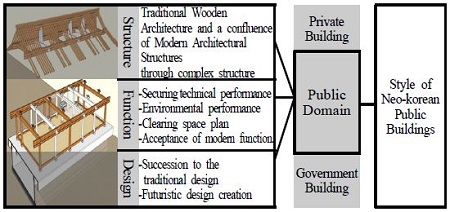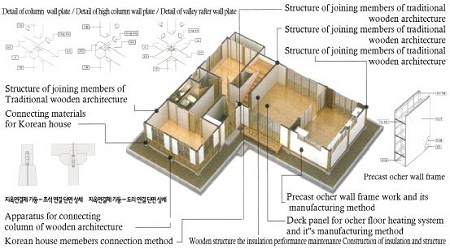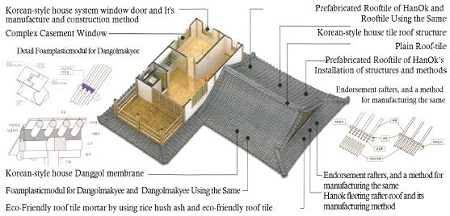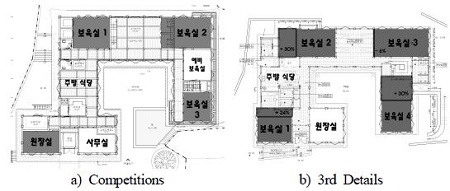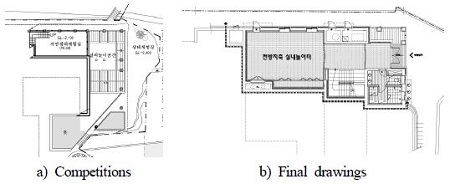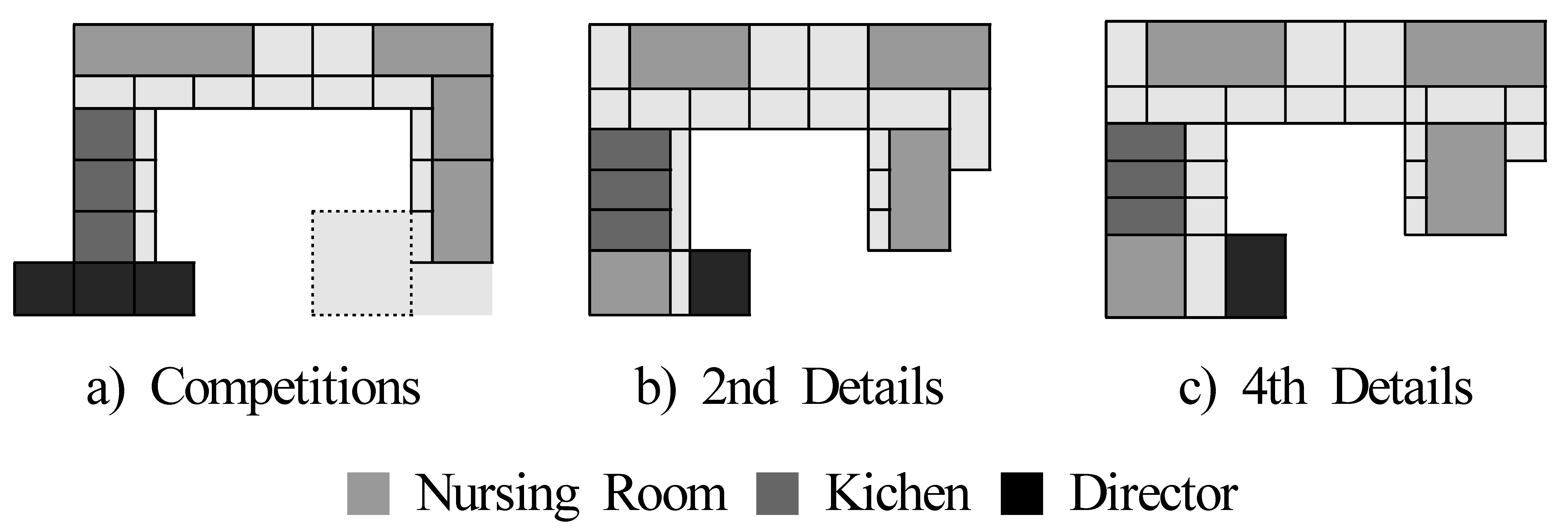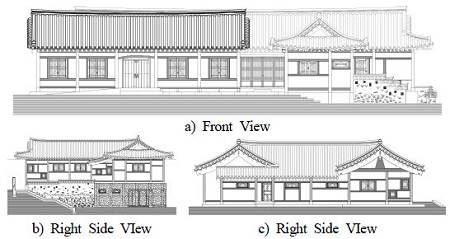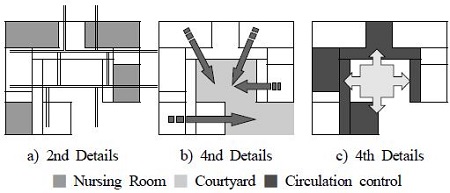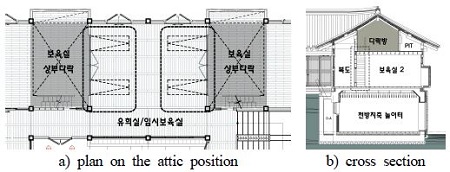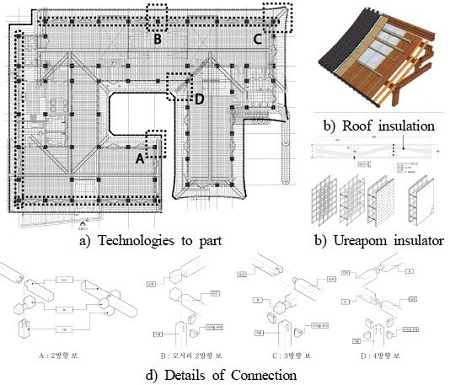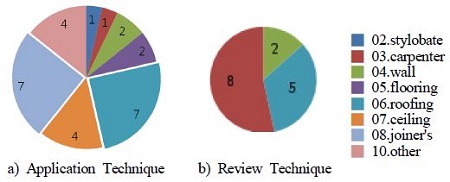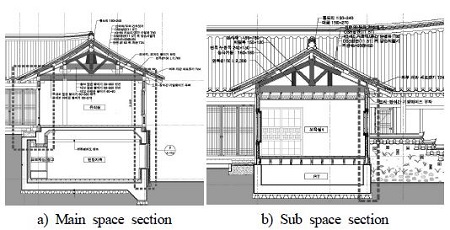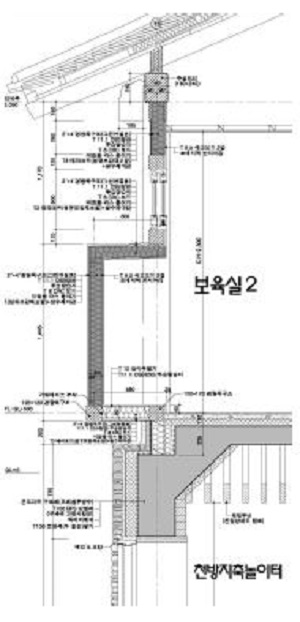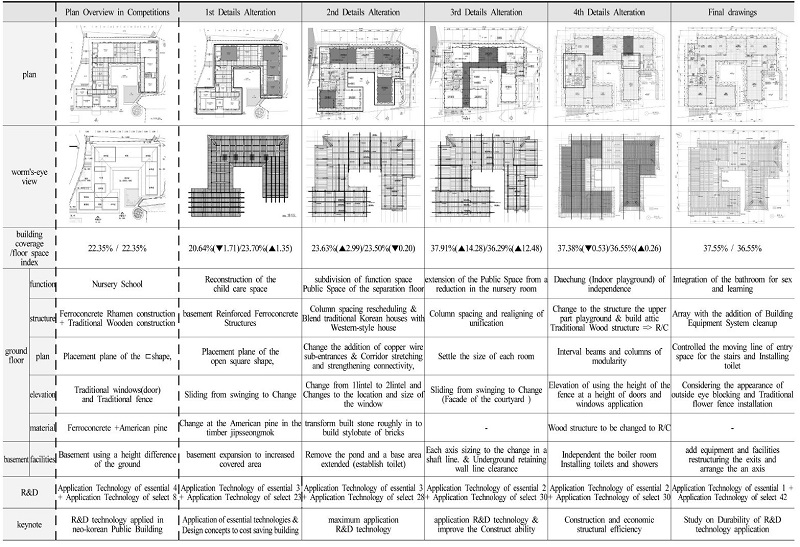
The Application Technology of Korean-style R&D in Verification for deploying the Neo-Korean Style Public Building : Focused on the R&D Technologies in Changed Drawings of Neo-Korean Style Public Daycare Center in Sunchang-gun, Korea
ⓒ Copyright Korea Institute of Ecological Architecture and Environment
Abstract
This study is to research how New-Hanok R&D technologies of first stage are appearing and adapted to the New-Hanok style public buildings, especially in Daycare Center in Sunchang-gun, Korea. Unlike Hanok houses, public buildings which has special needs for the public and restricted by laws and regulations need not only new system of law incentives but also new components of New-Hnaok R&D technologies used only in Hanok house.
For this purpose, we checked the drawings for Daycare Center in Sunchang-gun. The drawings have been changed 6 times for the purpose of adopting New-Hanok R&D technologies of first stage and actual needs for current laws and regulations for public buildings and it reveals not only the possibilities for adapting new technologies in New-Hanok but also meetings the current and public needs for public buildings.
The result of this study as follows. Approximately 40-50 percent of New-Hanok R&D technologies in the first stage are adapted in Daycare Center in Sunchang-gun, and this means there are limitations in adapting New-Hanok R&D which are mainly for the Korean style houses. The main reasons are the costs still remaining high and lacking in confidence for using traditional structures and materials still under verification. Some are changed and proposed in another solutions suitable for public buildings as like truss structure system in roof.
Keywords:
New-Hanok Type, Neo-Korean Style Public Building, Applied Techniques by part in Hanok, Public child care facilities키워드:
신한옥, 신한옥형 공공건축물, 신한옥 R&D 기술, 공공어린이집1. Introduction
1.1. Research background and Purpose
As hanok (traditional Korean house) started to receive re-evaluation for its value from the late 1990s, a variety of studies began after 20071), upon the legal and policy issues related to the activation and promotion, the current status and characteristics, and distribution of hanok. As even each local government established various policies2) for hanok or hanok village, public interest in hanok was never higher. Despite such achievements and the governmental efforts, however, the institutional problems around hanok still remain because the main focus on hanok has been biased toward its preservation and control as well as its performance and economic aspects. Therefore, it I is high time that more researches and studies had to be continuously carried out to verify the practicability of hanok and to spread it in future.
To tackle these problems, contribute to the popularization of traditional housing culture, and establish diverse environmentfriendly housing space, the 1st stage of Hanok Technology Development R&D Project commenced from 2009 and it made some place for developing hanok new technologies in area of hanok architecture technology and materials, which had been limited. Yet, it is necessary to study on the construction performance improvement and variable characteristics by space function in order to expand the applicability of hanok technology to other types of buildings other than residential houses and to enhance reliability and responsiveness to various needs. Starting with this background, realization of new hanok-style R&D technology for public buildings new hanok-style R&D technology developed to an exemplification project that was applied with the results of the 1st stage of Hanok Technology Development R&D Project and then is leading to verification stage, which is the second stage of Hanok Technology Development R&D Project.
Among the cases applied with the 2nd stage of Hanok Technology Development R&D Project, the present study examines the designing process of Sunchang new hanok-style public daycare center (hereinafter called 'new hanok-style public daycare center), which was the case to which the concept of new hanok-style public building was applied for the first time and proposes a plan to improve the designing of hanok-style public building so as to expand the applicability of technology for new hanok-style building and maintain competitiveness of it. In addition, this study expects that a series of processes in which new hanok-style application technology was applied to public buildings can be used as a guideline for new hanok-style design in future.
1.2. Research Method and Scope
The methodology that this study adopts are as follows. First of all, this study looked into the results of R&D technology proposed in the 1st stage of Hanok Technology Development R&D Project in order to expand and apply new hanok technology that was mainly applied to lodging houses to public buildings . And then it analyzed a daycare center in Sunchang-gun, which was selected through a public contest3), among public buildings to which new hanok technology was applied to know the application status of new hanok technology and the reasons for not being applied. As analysis method, this study compared the original prizewinner drawing and drawings that has changed until working design came with respect to laws and regulations, or ordinance, requirements of public buildings and construction method to save cost. Based on the findings, this study analyzed the design document to examine the scope of in which new hanok technology was applied to the public daycare center design and how it was added or deducted during the changing process of the drawings. The scope of this research is limited to the public daycare center in Sunchang-gun.
2. New Hanok-Style Public Buildings and Outline of Hanok Technology Development R&D
2.1. Summary of Precedent Studies and Current Status of Hanok Technology development R&D4)
Project for the Development and Construction of Optimal New Hanok-Style Public Building Model is a technology development R&D project initiated by Korea Agency for Infrastructure Technology Advancement (KAIA) to pave a ground for hanok architecture, aiming for the globalization of hanok and making it tourism asset and culture through developing and spreading ‘Han-brand’, which is an extended concept from hanok that is a high-class and environment- friendly house.
The 1st stage (3 years and 9 months from 2009)5) of the project places its goal in succeeding to the brand value of traditional hanok and developing public hanok that serves the performance of modern residence at low cost (about 60% of traditional hanok). The 2nd stage aims to popularize and disseminate hanok technology through developing hanok village and public hanok architecture, and to establish examples to contribute to the settlement of hanok housing culture. The present study is part of (3 subsection of objectives of) “Project for the Development and Construction of Optimal New Hanok-Style Public Building Model” of Hanok Technology Development R&D Project of ".
2.2. Definition of New Hanok-Style Public Building and Its Legal Necessity
Under the current law, the definition of ‘new hanok’6) is not settled down. Rather, various terms are used such as ‘new hanok’ ‘improved hanok’ or ‘modern hanok’.
According to academic definition that has been established through previous studies, ‘new hanok’ is an improved hanok-style building to which advanced wooden architecture technology and system as well as traditional value of original hanok is applied to adapt to modern life and environment7).
‘New hanok-style architecture’ is a concept that includes ‘new hanok’ and also considered as belonging to ‘architectural assets’ and ‘hanok architecture style’. In addition, it is the concept to extend ‘settlement’ of hanok to various buildings along with the elements of ‘hanok’ and ‘modern architecture’. Therefore, ‘new hanok’ has a potential to extend to public buildings8) as well as houses through succeeding to the merits of and improving demerits of traditional hanok. Accordingly, new hanok-style architecture can make enough place for improving the unsuitable elements of traditional hanok for modern architecture through employing modern architectural technology.
The academic definition of new hanok-style public building9) is “a main building, its attached building and Korea-style outdoor space10), of which principal structural parts such as column and (cross)beam are made in wooden structure and added with modern structure such as reinforced concrete or steel structures, that accommodates various functions through variable space planning; succeeds to Korea traditional beauty; reflects both the elements of reinterpreted traditional beauty and the future - oriented designing factors; is closely related to the daily lives of residents; and enhances the welfare of residents, cultural benefits and exchange.”
Because the definition of the current law on ‘new hanok’ draws an ambiguous line between traditional hanok and ‘new hanok’, it can exclude ‘new hanok’ from the government supporting system or pause a limitation to establishing a policy for the national asset. Therefore, taking advantage of such preservation policy as hanok registration system11), it seems also necessary to provide new hanok financial support and remove unreasonable regulations to distribute and expand new hanok. Particularly, since new hanokstyle public building is combined with the concept ‘new hanok’ and the object ‘public building’, it is apt to define it as the latter. As a result, new hanok can collide with the ordinances of local government such as barrier-free certification12) or environmentfriendly certification and thus it can have impact on the application of new technology or on the expansion and distribution of new hanok. Therefore, it is necessary to define new hanok-style public building legally and prepare an institutional device for it.
2.3. Classification of Hanok Technologies Applied to New Hanok and Required Applications
New hanok R&D (Research and Development) technology is the government-led developed technology to promote and popularize hanok. It was researched and developed to improve construction methods that heavily rely on experts and improve the general performance of materials. It has ultimate goals of spreading and popularizing hanok by reducing consumer price of hanok and building distribution structure based on mass production. Table 1 shows and classifies technology to be applied to the 2nd stage of Exemplification Project among the technologies applied to new hanok at the point of the completion of the 1st stage of Hanok Technology Development R&D Project.
The R&D technologies for design and construction by process are classified as 11 (required), 16 (selective) and 61 (additional). While required and selective technology group haven’t changed much, additional technology group takes greater portion (69%) in the total technologies.
Application of the elements of new hanok-style R&D technologies to public buildings at the stage of exemplification is very important for substantiality and reliability of R&D technologies. Especially, new hanok technologies in required application group are essential for construction of new hanok-style public buildings.
More than half (7 or 64%) of 11 required R&D technologies are design program and the related software, and 5 technologies are related to construction. 5 construction technologies are block fence using fence blocks and hanok-style fence using fence panels, Korean-style house tile roof structure, method for constructing insulation materials and structures and Dangolmakyee module of foamed plastic.
2.4. Summary of Key Hanok R&D Technologies Applied to New Hanok
New hanok application technologies were researched and developed to overcome the weakness of the technology and material performance of traditional hanok architecture and reflect the dwelling needs of the moderners.
Figure 2 and 3 summarize show key hanok R&D technologies applied to new hanok, which will help understand unique characteristics and review standards in designing new hanok.
Structure of joining members of traditional wooden architecture is technology that traves (crossbeams) are directly connected to each other, so it can prevent load on crossbeams from delivering to column and it secures structure rigidity. Also, brackets are allocated in the direction to crossbeams, thus increasing bending resistance. It improves traditional jointing and increases rigidity 6 to 10 times as well as overcomes irregular structure performance by restraining deformation by twists and cracks. More than anything else, this structural technology can secure economic feasibility through energy saving, which results form improved quality.
Precast ocher wall frame are made of natural materials which improves insulating performance, and uniformally mass-produced in a factory, to build highly stable and rigid walls by fastening wall tie steel with wall frame. Eventually, it has merits of saving construction cost by factory production and field construction cost.
Endorsement rafters do not manage a roof even due to corrosion by rain. because it requires to replace only endorsement rafter, it is easy to maintain. In addition, it can save cos by dry construction method and standardized construction by 25% of total timber needed for construction. While a carpenter can make 8 rafters in an old traditional way, this technology can increase production capability by 5 times, at least.
Dangolmakyee secures good constructability and economic feasibility using modular system while dry construction method can also reduce the period of construction and save construction cost, maintaining product quality at uniform and consistent level. Therefore, it is a technology that ensures durability and air tightness. Above all, Dangolmakyee has flexibility so it improves air tightness , which leads to high insulation performance.
Because Dangolmakyee is made of such modules mentioned above, it does not need molding and curing. Therefore, it can shorten the process of installation to great extent and also block air leakage and avoid thermal bridge regardless of the surface shape of trave. Adding length-adjustable bumps at the bottom side of a module enables its application to a rafter at various slops.
3. Analysis of the Technologies14) Applied to New Hanok-Style Public Daycare Center
3.1. Background and Summary of New Hanok-Style Public Daycare Center Construction
The exemplification project of new hanok-style buildings is aimed to change social awareness and pave a way to new hanok-style building by constructing and distributing large public buildings in new hanok-style, which have great ripple effect. Grafting new hanok-style application technology on child daycare facility among public buildings can be an alternative that provides infant facility, which is placed at the center of social attention and interest, with pleasant nursing environment . Besides, it is expected to have a great impact on infants' and young children's emotion by helping them recognize traditional culture at early stage and furthermore can be used for villagers to experience differentiated traditional culture. For the expansion of new hanok-style public buildings, it is also expected that the location advantage of using Bangchuk village on the corner to Gangcheonsan County Park, where more than 1.5 million tourists visit every year can be a great possibility to be a tourism asset.
Sunchang public daycare center is a new hanok-style daycare facility, located in Geumgwa-myeon, Sunchang-gun. Its building area is 337.92m2 and the basement floor is built in RC structure and the ground level is designed in wooden structure. Table 4 shows the architectural details of Sunchang public daycare center.
3.2. Design Modification Process of New Hanok-Style Public Daycare Center
Since the prizewinner drawing of Sunchang public daycare center was selected, it has been revised 6 times. Table 3 shows the major changes of 6 revisions. As seen in the table, the key changes of the 2nd and 3rd master plan are layout readjustment and changes in plane allocation and elevation drawing to establish pleasant environment for the daycare facility. The change of building area secured underground space, aiming to improve nursing environment by cancelling a pond that was worried out safety risk and dispersing indoor playground and equipment space into the basement.
The 3rd and 4th modification were made to respond to reduced construction cost and improve construction performance by changing elevation design according to which windows were using middle and high lintels. In addition, the distance between beams and columns was rearranged to secure the passage of 2.7m connected to the main space, which gives overall balance to the space (change of floor area ratio).
The 5th revision was attempted to arrange axis and layout readjustment before working design. The interval of column and beam was modularized to increase construction performance and economic effect. And basement’s indoor playground and equipment facility were located separately to secure safety for children.
From structural point of view, modern construction technologies were actively accepted for the underground level by replacing the wooden structure of the upper part with RC structure while the upper part of ground-level nursing halls was designed as attics in order to represent traditional space. Except the upper part of Daechung where structural frame is exposed, the upper part of the boarded ceiling was structured in truss construction method (Korean style) to secure construct ability and economic feasibility.
3.3. Legal Status and Institutional Problems Related to Designing New Hanok-Style Daycare Center
After 2000s, many efforts were made to improve laws and regulations related to hanok. Most of them were ordinances or district unit plans that aim to preserve and maintain hanok and the characteristics of hanok concentration area . As a result, the basic frame for preserving hanok and hanok concentration area was prepared and those efforts are evaluated to have achieved desired outcome15).
Along with the revision of Enforcement Decree of Building Act on February 18th, 2010, clauses regarding hanok was comprehensively improved. Such revision focused on lifting legal barriers off hanok in line with nation-level promotion projects to improve and supplement constraints on hanok construction.
The daycare center for this study was designed in accordance with Sunchang-gun ordinance and its drawing was made under Infant Protection Act besides general architecture laws and regulations. According to Infant Act of Table 3, facility area should be more than 4.29m2 per infant child; nursing room should be larger than 2.64m2 per infant child. The building area and nursing area of Sunchang daycare center are 8.66m2 and 3.73m2, respectively, which are 2 times and 1.4 times greater than the requirements16). In addition, because it is subject to facility laws regarding infants and children among applicable laws and regulation concerning the elderly, the infant and children and the disable, it had to have a ramp (slopeway) in access routes nd main entrance.
3.4. Changes in Plane Plan
The plane design of Sunchang daycare center has been changed 2 or 3 times by which the nursing rooms were decentralized. Nursing room for Age 0 was located near director's office (management office) so as to minimize the moving route for coming in and going out of the building, which was done helping nursing teachers respond to emergency quickly. The relocation of the nursing rooms led to the reduction of the area size per room, but increase in the number of nursing room.
From the perspective of nursing teacher and manager, this dispersing placement has demerit of longer moving route, but has merit of making nursing rooms more independent of each other, which is more suitable for systematic educational program by age.
Table 6 shows the changes in the area of nursing room. Over several revisions, each size of the nursing rooms had become similar. They were changed in a way to help young children at the age of 1 through 3, during which their space recognition develop, easily adjust themselves to space while moving the routes . Space area is very important for infant and child development. therefore, these changes were very critical17).
At the same time, the underground space was utilized so that ground-level space could be solely used for nursing rooms. The front pond suggested in the original drawing was cancelled and instead equipment space was concentrated on the expanded ground space. And wide windows were installed for natural lighting.
As a result, the two floors were separated both functionally and environmentally: dynamic activity space (indoor playground) was composed on the basement floor while ground floor was characterized with nursing-intentive space, both of which gives stability to the whole environment.
The 2nd, 4th, and 6th revision of design of Sunchang daycare center show distinctive change in plane space. As seen in Figure 6, the changes in plane stemmed from changed modules by column rearrangement. In the original (prizewinner) drawing, the plane was designed with 8 spatial blocks in front and 7 spatial blocks at the sides, forming ㄷ-shape. But the final drawing shows that the plane turned into an open-mouth shape and the number of spatial blocks also changed to 9 spatial blocks in the front and 5.5 spatial blocks at the sides. The breadth between columns became longer from the 2nd to the 3rd revision, because of which floor space could be enlarged and the number crossbeams of the front Matbae (gable) roof increased from 5-ryang to 3-ryang and at the same time Koju of Daechung was removed to expand indoor space.
In the 5th revision, the interval of the front columns narrowed down and that of the side columns was broadened to secure breadth for safe hallway, removing unnecessary columns. As a result, the overall internal of columns was uniformed and the structure of the upper part upper became more efficient for purpose.
In hanok, the most essential design element for esthetic identity lies in the roof. Even the whole value of a hanok building can depend on the shape and materials of a roof. In fact, the shape of roof part is closely related to upper structure, so finishing elements are different by structural analysis. The main building of Sunhang daycare center has Pakjak (hipped-and-gable) roof in principle and the unit of the front entrance has Matbae (gable) roof, which present the diversity of hanok. (See Figure 7)
As for window composition, the front contacting the atmosphere was equipped with casements of Seisal (slender ribs) to present traditional features and the inside was equipped with the sliding doors of Ajasal and Sutdaesal to utilize space. The entire windows were designed in consideration of the physical size of infants and young children. Hainbang (the baseboard of a room) and the thresholds were cleared off the upper rails were used instead to secure safety for young children.
Cubic elevation composition in Korean-style structure is not only suitable for spatial composition for users, but also presents the value of hanok to visitors.
Most of private daycare centers are built in centralized spatial composition where nursing rooms are arranged around a living hall in the center. It is because house-type facility is combined with daycare facility like in private daycare house. In addition, because nursing teachers take divided roles, they need relatively short radius of observation and short moving routes. However, hanok has a limitation to spatial division because its space is composed of each separate space (room) and they are unified as a whole.
On the other hand, the independence of each room can be established and easy and convenient access to any room can be achieved through toenmaru (porch hallway).
As seen in Figure 8, all the moving routes were designed to face and reach Daechungmaru (indoor playground in this case) because easy access from each room to the courtyard as well as Daechung to (main floored hall) ensures disengaged group activity. Here, Jjokmaru (parquet floor) was installed in the front to secure convenience of access to the courtyard.
It was from Chosun Dynasty that an attic appeared in a Korean traditional house18). The attic of a house of nobility was relatively spacious enough to be used a resting place during hot summer season, but the attic of the most ordinary houses was mainly used for storing things. Using this attic as indoor activity room, Sunchang daycare center paid modern attention to it as a place to stimulate infants’ and young children’s curiosity and also as a storage room for teaching tools and materials. In addition, the center installed duluyeolgimun (up-folding door) instead of a wall between a nursing room and the floor so as to make a wide space when necessary, which was intended to reflect a typical function of traditional maru (floor).
4. New Hanok Technologies Applied to New Hanok-Style Public Daycare Center
4.1. Technologies Applied to the Drawings of New Hanok-Style Public Daycare Center
Examining the working (final) drawing, it turned out that only 28 or 32% of the total 43 new-hanok technologies were adopted or considered for Sunchang new hanok-style daycare center and 15 (17%) technologies are in review again to minimize the variables that occur during the construction. Of the required technologies, only ‘construction technology of insulation materials for wood structure’ was applied to the center.
When examining the final working drawing documents, it was known that the roof and window construction of the center adopted new hanok application technologies the most, which take 25% (7 technologies) of the total new hanok technologies applied to the center. Even when including the number of applicable technologies to the roof and window construction later during the construction, the proportion is far higher than any other processes of the construction. In short, the roof and window construction uses 67% of applicable new hanok technologies.
Although it is roof and window construction that the largest number of technological elements had been developed for, it also indicates that studies are focused on roof part that much to increase its efficiency in new a hanok-style building.
Window construction is also an area of active R&D technology efforts because it is necessary to solve the problems that traditional hanok has, such as heat insulation, soundproofing, and prevent thief. The key technologies adopted for Sunchang daycare center to improve the performance of hanok include construction technology of insulation materials for wood structure; manufacturing technology of double-rafter for hanok roof; and technology of foamed plastic Dangolmakyee module construction.
All of those technologies mentioned above were actually applied to the project after discussion and review between the construction designers and the construction companies and they placed in consideration changeability subject to construction conditions.
4.2. New Hanok-Style Technologies not Applied to Sunchang Daycare Center
The plane of hanok is determined by column arrangement and beam is used depending on the omission of column. Therefore, many horizontal members of framework are fastened to each other to secure the stable fixation of columns19). As a result, load concentrates on roof structure section, which has critical impact on construction cost. Therefore, new hanok application technologies are focused on wooden structure sections, as mentioned above.
Nonetheless, the most technologies were excluded from such major construction processes as carpenter's work, roof construction, and walls construction.
Table 8 shows 45 new hanok-style technologies not applied to the construction of Sunchang daycare center.
No applicable process (19 technologies) and discrepant design condition (9 technologies) account for 62% of the total unapplied technologies. of the required technologies inlcuded in the original design (prizewinner desing in the contest) but finally excluded, ‘hanok-style fence using fense panels’ was also exlcuded due to changed design condition. What is worth paying attention to here is ‘if-case’ where the technologies (27%) of the original design.
Particularly, it was the developed technology for roof construction, but it was evaluated less efficient than the technology of the original design in terms of constructability and economic feasibility. As a result, it was excluded. Increased construction cost was responsible for the most of the excluded technologies.
4.3. Improvements of New Hanok Technologies
As for 15 technologies of which application to Sunchang new hanok-style daycare center were held off, on-site review was scheduled to review the application. The group of these technologies is construction techniques that may need reinforcement materials in process of construction or is hard to measure its performance after construction. In addition, the group belongs to the case where there is no error in construction but (subsidiary) material cost is too expensive, so that economic feasibility is very low. As a result, it was determined that improved technique from existing materials would be used.
Unlike the technologies that were excluded from application due to excessively expensive cost of construction, these technologies should be reconsidered and recommended for their applicability and recommended. That is, it is possible to propose improvement by combining these technologies with commercial materials to increase economic feasibility and functional flexibility.
Particularly for roof construction, these technologies are different from existing construction method, so there are high chance to change in process of construction. Looking into the improvement plans, the proposed Dangolmakyee-related technolog y20) caused thermal bridge when timber was twisted. Therefore, double-layered Dangolmakyee insulators were used and the gaps of rafters were fastened with timber plates.
Meanwhile, when hanok roof21) was constructed, such space as (playroom, reserved nursing room) where consists of rafter-exposing ceiling was constructed with Korean-style roof structure and nursing rooms and director office which were finished with boarded ceiling were constructed in truss structure together with partitioned boards. Earth was not used. Instead, timber composed roof curves and plywood was placed on the partitioned boards and insulators were constructed on it.
As seen in Figure 12, tempered glass was constructed between crossbeams on the elevation inside the attic to secure safety and esthetic value after construction. The elevation facing the nursing rooms was composed of wooden louvers to give vidual effect of not making low space not feel heavy. Like this, these methods to apply and complement exiting new hanok technologies should be considered in securing or developing technology in future.
4.4. Limitation of Applying New-Hanok Application Technologies to Public Buildings
The availability of these application technologies to Sunchang new hanok-style daycare center design is determined in the previous stage before each technology is applied. It is directly related to economic feasibility and efficiency. In other words, even though two technologies have similar strength and construction performance, a technology that requires materials of high purchasing cost is eventually evaluated to be less efficient. However, it is very necessary to have verification process of new technologies so they can have economic feasibility and, above all, it is most important to check the problems in distribution after application.
The 88 application technologies were designed and developed for residential hanok.
Therefore, they have limitation to applying space that requires long span and there must be selection standards for materials by facility group.
Figure 13 shows the sectional detail drawing of back elevation of Daechung. The walls displayed on the drawing belongs to walls construction in terms of application technology and the specification reads it should be finished with red clay panels on which Hanji wallpaper is applied. But the characteristics of the daycare center, which is not residential building, was considered and therefore was finished with double-layered plaster boards on which Hanji wallpaper is applied.
As sensed here, the lack of hanok technologies applicable to designing large-scaled space is the very limitation of new hanok-style technology. Therefore, new hanok-style application technology needs to be studied and developed for diverse application.
5. Conclusion
Korean society has a great expectation for new hanok-style public buildings as an example to lead the advancement of hanok culture and establish desirable public buildings. However, existing wooden structure of traditional hanok construction faces limitation to meeting institutional and social requirements for a public building. Therefore, many technologies have been developed to realize the traditionality of hanok in a broader range of architecture. Among them, new hanokstyle technologies applied to a public daycare center was the first case that the applicable scope of new hanok technology, which used to apply to a residential space, expanded to new hanok-style public building, where its significance is found.
The present study examined the changing processes of the designs of Sunchang new hanok-style public daycare center, aiming to propose the scope, limitation and future direction of new hanok technology. The findings of this study are as follows.
- 1. The changing processes of the designs of Sunchang new hanok-style public daycare center was focused on functions of the daycare facility: floor space was rearranged; interval of columns were adjusted to make balance between the main building unit and its annexes. As a result, space efficiency and construction performance were enhanced. Through the revisions, traditional and modern spatial composition method were complemented with each other and the weakness was improved.
- 2. In introducing new hanok technologies to design process, user-oriented spatial composition plan should come first in priority in the direction that traditionality is reflected in new hanok and existing construction performance improves.
- 3. Such architectural elements as window, fence, and Daechung should be utilized to maintain traditional beauty and modern materials should be combined with new hanok technologies to increase economic feasibility.
- 4. The main and most reason why developed new hanok technologies are excluded from application is low economic feasibility. Therefore, existing designs should be actively accepted, reflected and reinforced to find the most efficient alternative.
- 5. It was found that the new hanok-style public daycare center was an attempt to combine the principal structural part of wooden structure such as traditional columns and beams and modern construction method of RC (reinforced concrete) structure and to respond to the modern demand for various functions for a public building through variable spatial plan.
Public facility is a public goods that provides citizens daily place and a representative social infra facility that responds to the needs of the times. Applying new hanok-style building technology to a public facility can be an effective means to activate hanok. In this respect, studies continues in a way they help hanok construction project be free from institutional and structural problems and actively embrace modern technologies. If it is expected that hanok R&D exemplification project becomes effective enough to playa central role in spreading hanok culture, it needs the government to improve related system and actively support the development of software programs necessary to develop new hanok architecture.
Acknowledgments
The present research has been conducted as part of projects supported by research fund of Korea Agency for Infrastructure Technology Advancement (KAIA) in 2014. Project Number: 14AUDP - B070934 – 02
Notes
References
-
양재영, “朝鮮時代 多包式建築의 架構 發達過程에 關한 硏究”, 박사학위논문, 고려대학교 대학원, (2007).
Yang, J,-Y., “Study on the Development of Framed Structure of the Wooden Architecture with Multiple Bracket Sets in the Joseon Dynasty Period ”, doctorate thesis, Graduate school of education korea university, (2007). -
김윤경, “어린이집 보육실의 내부공간계획에 관한 연구”, 석사학위논문, 건국대학교 산업대학원, (2002).
Kim, Y-K., “Study on the planning of Inner Space for the Nursing Room of Child Care Facilities : Focused on the Educational tools”, master's thesis, Konkuk University, (2002). -
이경아, “한옥 보전을 위한 법령 개정 효과에 관한 연구”, 대한건축학회 논문집: 계획계, 30(5), (2014).
Lee, K-A., “A Study on the Effectiveness of the Law Amendment for Hanok Conservation”, Journal of Architectural Institute of Korea, 30(59), (2014). [https://doi.org/10.5659/jaik_pd.2014.30.5.121]
-
권영상, “신한옥마을 시범사업시행방향 및 기준마련을 위한 연구”, 한국 토지주택공사, (2009).
Kwon, Y-S., “Research directions and guidelines for the implementation of pilot projects on neo-hanok town”, LH, Korea Land Housing Corporation, (2009). - Park, J.Y., (2015), The Design Elements for the Model Development of New-Hanok Type Service Facilities in Apartment Housing, Journal of Architectural Institute of Korea ’ s ecology, 15(3), (2015).
-
정은성, 新韓屋의 供給活性化 方案에 관한 硏究, 한양대학교 석사학위 논문, (2014).
Jung, E-S., “A study on vitalization plan for neo-Hanok supply”, master's thesis, (2014). -
권경순, “한국 주택의 다락 공간에 관한 고찰”, 婦學, 4, (1971).
Kwon, K-S., “A Study on the attic of Modern Korean Houses”, Journal of 婦學, 4, (1971). -
이종찬, “신한옥형 공공건축물 활성화를 위한 Barrier-Free인증제도 개선 방안에 관한 연구”, 한국생태환경건축학회 학술발표대회 논문집, 통권28 호 15(1), (2015).
Lee, J-C., “A study on the law and regulatory policy implementation for revitalization for Barrier-Free certification system of Neo Han-Ok style public Building - Focusing on the case of Agricultural Research Services, Naju-si, Jeollanam-do, Korea”, Journal of Architectural Institute of Korea’s ecology, 15(1), (2015).
